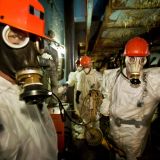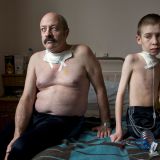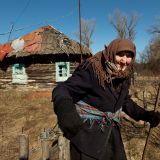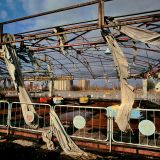Gerd Ludwig
The Long Shadow of Chernobyl*
General Guisan Quai
There are no words for the devastation caused by Chernobyl. Gerd Ludwig made 12 visits into the Exclusion Zone over a period of 25 years. The result is a deeply personal journey into a landscape forever changed and a frightening record of an environmental and human tragedy. From victims living with emotional and physical consequences, to the Exclusion Zone created by the evacuation of over 250,000 people, to the abandoned city of Pripyat, once a scientist’s dream for its quality of life, yet now uninhabitable, it is a record of almost unbelievable suffering and desolation. Working under enormous time and radiation pressure, Ludwig ventured deeper into the belly of the beast than any other Western photographer, repeatedly documenting the destroyed reactor #4, which has now disappeared under a “New Safe Confinement” for at least 100 years. First and foremost, it is a project to remember the people – those who lost their lives, and those who continue to suffer this tragedy, and an emotive, thought-provoking, and necessary testament to the world’s worst nuclear disaster to date.
Thus, it becomes an important voice in the continuing political, environmental, and economic discourse on the safety of using nuclear energy – and a warning to human hubris, serving as a reminder that not everything that is technologically feasible is also wise.
German American Gerd Ludwig is considered a pioneering documentary photographer of our time. He studied under Prof. Otto Steinert at the Folkwangschule in Essen, Germany. After moving to the U.S., he became a core member of National Geographic Magazine for three decades. His dedicated coverage of the aftermath of the Chernobyl nuclear disaster is considered a milestone of modern photojournalism.
He is the recipient of the University of Missouri Medal of Honor for his outstanding achievements in journalism and the Dr. Erich Salomon Award of the German Society for Photography.
* open your eyes acknowledges the correct Ukrainian spelling of “Chornobyl”. Since both the creation and the accident of the nuclear power plant occurred during the time of the Soviet Era, in which Russian was a second state language, the spelling of “Chernobyl” has become established.
Curated by Gerd Ludwig / Printed by ![]()
Discover here contributions of ETH Zurich to the Sustainable Development Goal (SDG) 9:
Housing that doesn’t cost the planet
Oxara
The ETH spin-off company Oxara was co-founded by Gnanli Landrou, who comes from Togo, and Thibault Demoulin, who comes from France. Both have an academic background in materials science.
Growing up in West Africa, Gnanli was involved actively in the construction of earth houses, and this helped to shape his perspective on material use. This type of construction is also common in Thibault’s native region of Brittany, which has a tradition of earth-built housing.
Through their experiences and conversations, Gnanli and Thibault discovered a common fascination for earthen materials. Their individual encounters with earth-based construction in different locations converged into a shared appreciation for the unique qualities and potential of sustainable building approaches.
Enabling sustainable construction and affordable housing
According to UN Habitat, 3 billion people will lack access to decent, sustainable, and affordable housing by 2050. But building enough housing comes at a cost for the planet. Conventional building materials such as cement, concrete and bricks are responsible for 10% of global carbon dioxide emissions, and account for one third of global waste.
Oxara aims to upcycle construction waste such as excavation material and demolition waste into sustainable and affordable building products. It does so by offering a range of specialised admixtures & binders, which enable the company to make use of existing infrastructure and processes to promote fast adoption of new technology on a large scale.
The products made by Oxara can cut the carbon footprint of building materials. Upcycling of waste material also reduces the need for intensive mining. Ultimately, the company makes it possible to build more sustainable and affordable homes.
Public awareness for sustainable construction and circularity
Oxara encourages real estate developers, building owners, builders and material producers to commit to making future homes as sustainable as possible. They can do this by using less or no cement at all, using clay-based and bio-based resources, and upcycling as much waste material as possible to promote circularity.
For now, Oxara operates mostly in Switzerland. But the goal is to demonstrate that their approach also works in other parts of the world. Work is now underway to prove the efficiency of their product in a number of countries including India, Rwanda, and Tanzania.
“The time for a change is now! Together, we can improve people’s well-being and have a healthy environment to live in.”
Dr. Gnanli Landrou and Dr. Thibault Demoulin, Co-Founders of Oxara
Choosing what’s best for the environment
Stefanie Hellweg
In the early days of her life as a university student, Professor Stefanie Hellweg made sure to attend all courses related to environmental technologies that were available at the time. The passion for environmental issues evolved into an interest in the field of Life Cycle Assessment during her doctoral studies. At that stage, she became attracted to the idea of adopting a systems approach to materials recycling, and carrying out comprehensive assessments of technologies or products across their life cycle, ‘from cradle to grave’. This approach allows for effective decision-making to identify the best environmental solutions to a given problem.
Measuring environmental impact
Stefanie and her research group develop and apply methods that support decisions on sustainable production and consumption. They aim to understand how greenhouse gas emissions and resource consumption affect the environment, and can quantify the impact of products, processes as well as new technologies. Their work now focuses on the circular economy, specifically the study of the benefits and impacts of material life cycles.
Climate change and biodiversity loss are the biggest threats of our time. Stefanie and her group identify levers of change that can contribute to mitigating and reducing these problems. When they assess and compare different material alternatives, for example, they are able to identify the most environmentally friendly options. As the built infrastructure is a major driver of greenhouse gas emissions, the team is investigating how urban design, buildings and other infrastructure can be improved to lower impacts on the climate.
Conscious consumption choices
Stefanie believes it is crucial that societies and economies undergo a profound transformation in how they approach production and consumption, if the world is to address the pressing climate and biodiversity crises effectively.
As consumers, each one of us has the power to make a positive impact by adopting a more conscious approach to our consumption choices. By being mindful of the environmental and social implications of our actions, we can do our part to address the challenges at hand. This means avoiding unnecessary consumption with a high environmental impact, and embracing more sustainable alternatives.
“In a sustainable future, we will have learnt to live within planetary boundaries. This requires that energy is ‘defossilised’, materials are efficiently used and cycled (e.g., reused or recycled), and people consume consciously and invest in sustainable assets.”
Prof. Dr. Stefanie Hellweg, Chair of the Ecological Systems Design Institute at ETH Zurich
Urban transport, reimagined
Kay W. Axhausen
Trained as a civil engineer, Professor Kay W. Axhausen has become an expert in urban engineering. Maps and urban plans mean more to him than the physical features they represent: they display cities as complex systems. By taking into account the social, technical, and environmental dimensions of cities, urban planners like Kay strive to foster community engagement, to ensure efficient management of infrastructure, and to promote sustainability.
e-bike city
Kay and his group are dedicated to decoding and forecasting travel behaviour. They do this by systematically measuring, simulating, and integrating valuable insights and data into a comprehensive, large-scale model. The current focus of this work is to explore the potential for creating ‘e-bike cities’ by reimagining existing infrastructure for bikes, walking paths or other public transport services. Part of this research involves examining the benefits and other implications of making such a dramatic shift in how the urban transport system is organised, in an effort to assess the feasibility and viability of sustainable transport taking centre stage within cities.
Their research and simulations aim to build scenarios that urban planners, policymakers, and others can use to shed light on the potential advantages and challenges associated with transitioning towards e-bike cities. Ultimately, by exploring ways to promote sustainable transport, reduce carbon emissions, and improve urban livability, their work contributes to shaping a greener and more sustainable future for urban environments worldwide.
New transport systems
Kay calls on policymakers to embrace an exploration of new ways to configure transport systems. He is convinced that, given the transport sector’s significant contribution to greenhouse gas emissions, new ideas and positive visions are needed to drive public discussions and gain voter support. Reducing the sector’s emissions will take innovation, interdisciplinary collaboration, and highlighting the broader benefits of sustainable transport. At the same time, to ensure that the energy transition is fair and just, social equity and a range of stakeholders need to be part of the conversation.
“By embracing interdisciplinary collaboration and systems thinking, cities can be designed to be resilient, inclusive, and environmentally conscious, meeting the diverse needs of their residents while preserving resources for the future.”
Prof. Dr. Kay W. Axhausen, former Head of Institute for Transport Planning and Systems at ETH Zurich
open your eyes festival buerau
Botenaustrasse 42
9443 Widnau
Switzerland
Phone: +41 44 218 11 03





